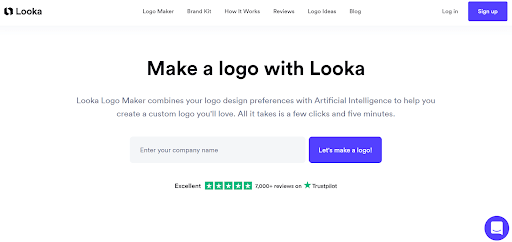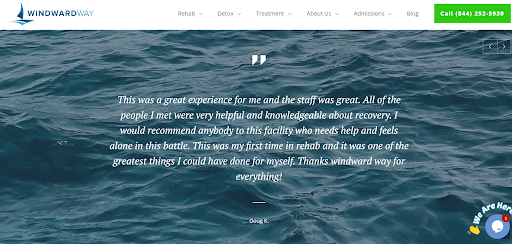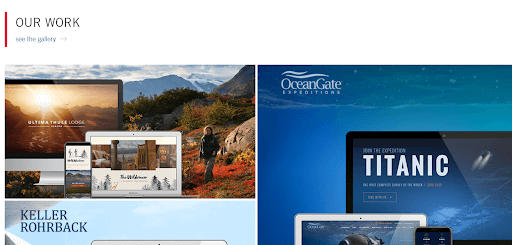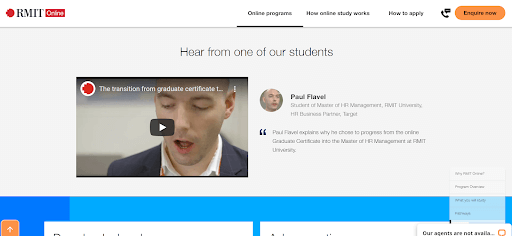When people get to your website, they’ll want to see that you’re actually good at what you do. So, in order to earn the trust of prospective customers and manage your nonprofit’s online reputation, you should consider adding social proof to your site. This will provide concrete evidence that you can be trusted to deliver, since you’ve done it in the past.
In this blog post, we’re going to look at five different types of social proof you can add to your website to build trust and credibility for your organization.
Star ratings your audience will notice at a glance
While your audience, donors, or volunteers want reassurance that you can be trusted, they may not want to spend a lot of time reading or watching long testimonials. So, why not show them—at a glance—the average star rating that others gave for one of your events or programs?
Reviews can also be particularly helpful. If you offer multiple programs or events that are quite similar, it makes it incredibly easy for prospective supporters to compare them. To collect these, you can send out a feedback survey form to your audience. Ask if they can rate your event or program and provide feedback on their experience with you. Once you’ve collected your reviews, you can display them in a section on your homepage, About Us page, or even dedicate an entire page to them.
Examples of this kind of social proof
Now, let’s take some inspiration from the for-profit world of businesses already using this tactic.

This example is from Looka, an online logo maker. Looka shows social proof by highlighting the excellent 5-star rating they received from past customers. Also, notice their mention of 7000+ reviews, which can be seen if you click on the link that leads to Trustpilot (an independent review site).
This kind of social proof works well because it’s straightforward, shows all the necessary information at a glance, and also links to the review site for credibility. To replicate this on your website, you can also highlight any star ratings or reviews your organization receives. Just like Looka, you can link back to any independent review site where you have a profile. This gives visitors the option to see more reviews if they want.

This examples comes from A Gift Personalized, a company selling customized gift items for different occasions. On their site, you’ll find that they also use star ratings that show how previous customers rated the products they purchased. At a glance, website visitors can see how different items have been rated and also view the total number of reviews for each product.
This helps provide proof that people are buying and enjoying the products. The placement of these reviews can also help prospective customers make better buying decisions. For your own nonprofit website, you should also consider simplifying the way you show reviews by using star ratings that will make it easier for people to see your reviews at a glance.
Written testimonials that provide a lot of detail
Depending on the programs or services you provide, your audience might feel the need to do some research before taking advantage. They’ll want to know more about the people you’ve helped before, what problems they were having, and how you helped to solve their issues.
Written testimonials are ideal for building trust with donors, customers, and even volunteers. This is because written testimonials include a lot of information. They show the range of people you’ve helped and also provide more context about your programs.
If you don’t know how to go about collecting testimonials, send a polite email to your audience. Ask if they would give feedback about your services and also ask if they would be willing to recommend you to others. After you collect the testimonials, you can display them on different pages of your website, like on your homepage. You should also try to include details like the names, job titles, and headshots of the people who are providing the testimonials. These will help show they are legitimate.
Examples of this kind of social proof
To give you a better idea of how this could work, let’s study some examples of brands that already use written testimonials on their websites to provide social proof.

Victoria University provides written testimonials for their VU Online Graduate Certificate in Finance. On their site, you’ll see written testimonials that provide a lot of context about the program and the experiences of students who have passed through the course. They also used best practices like adding the names and headshots of graduates who provided these testimonials. This helps to lend a sense of credibility to the reviews. You could also optimize your site by adding testimonials like this that show the names and headshots of your donors or volunteers as it can help build trust for your nonprofit.

Windward Way is a rehabilitation center based in Newport Beach California. On their website, they have several testimonials from clients who used their services. One of these testimonials, shown in the image above, provides insight into a patient’s experience at the rehabilitation center—and you can see it’s very positive. In fact, the patient makes a point of saying they will recommend the center to anyone who needs it. This kind of testimonial can be really helpful to prospective patients who are looking for information about what it’s like at the center. It could help them make a decision on whether or not to register.
You can also do something similar for your nonprofit website. Try collecting sincere feedback from people who have benefited from your programs or services. Then, create a section on your website to highlight their written testimonials.
Official awards or qualifications that are relevant to your work
Depending on the kind of industry you work in, you could display your any awards and qualifications from reputable organizations. This highlights the good work your organization does while also verifying your skills and knowledge. For instance, this approach would work well in the for-profit world for law firms who want to display their awards from relevant legal organizations. Let’s take a look at a website that uses this approach effectively.

The Law Offices of George Salinas, auto accident attorneys in San Antonio, do a great job of highlighting the various awards they’ve received. If you look at their site, you’ll find awards from institutions like The National Law Journal, Super Lawyers, American Association for Justice, and other authoritative bodies in their industry.
These awards reflect the firm’s authority in their profession. In addition, the awards help the company build more trust with existing and prospective clients. If you also have awards and qualifications from notable institutions in the nonprofit field, don’t hesitate to show these on your website as they help build your credibility.
Examples of well-known supporters who love your services
Have your programs or services have helped companies or individuals in the past? It could be a great idea to publicize this on your website—but first make sure they’re okay with you doing this.
When you highlight any well-known supporters, people will be more likely to trust and invest in your offerings. After all, if a well-known company has used and enjoyed your services, then why shouldn’t they? For instance, a web design company could highlight the websites they designed for popular businesses and organizations. Your organization could create a section on your homepage to display the logos of renowned companies that have partnered with you in your cause.
Examples of this kind of social proof
Let’s study an example of a company that showcases the work it has done for reputable clients as a way to show social proof.

Bizango is a web design and online marketing agency in Seattle. When you get to their homepage, you’ll see that they’ve created an entire section to show the work they’ve done for some well-known companies like Ocean Gate Expeditions, Ultima Thule Lodge, and Keller Rohrback. Plus, they also have a link to their portfolio so visitors can see the rest of the beautiful designs they’ve put together for other companies. Some might call this name-dropping, but it’s actually a very effective marketing tactic that could help a company attract more clients.
If possible, create a section on your website that highlights some of the companies you’ve partnered with. You could also include a mention of any notable charitable events you’ve done. As a result, this could help show social proof of your activities and possibly get you more donors.
Video testimonials that will feel relatable
If reviews aren’t enough for some people, you’ll want to do everything you can to show they’re legitimate. But how an you make them more relatable or more personal? Putting a face to a name can help, and video is a great medium for this. Video testimonials can feel particularly relatable for your prospective supporters because watching the videos will make them feel as though they’re chatting with someone who was once in their shoes.
When creating video testimonials for your site, you’ll want to follow some effective video marketing tips and best practices for nonprofits. One of them is to make sure that you create an outline of what the person giving the testimonial is going to say. Even though you don’t want the testimonials to sound too forced, you want to make sure they include important details.
These details will vary depending on who is giving the testimonials. A volunteer might talk about the experience they had while working with your charity. If it’s a donor giving the testimonial, you might want that person to highlight how your organization used the funds or gifts to make a difference. You can collect these kinds of testimonials by contacting your donors and supporters via email or phone call. Ask if they would like to record a video by themselves or work with you to create one that highlights their experiences with your nonprofit.
Examples of this kind of social proof
To give you some inspiration on how to use video testimonials on your website, let’s take a look at some organizations already doing this.

Florin Roebig is a law firm that specializes in practice areas like personal injury, medical malpractice, and labor law. On their website, you’ll see that they’ve added video testimonials. These include clients who came to the firm with different cases. And, if you watch the videos, you’ll see that they mention how helpful the firm was in solving their case. It’s a great way for the firm to relate with prospective clients. These testimonials provide social proof of the fact that there are people who trust their company and are all the better for it.

Finally, take a look at this example from RMIT Online, a university that offers graduate-level programs. One of their courses is the Online Graduate Certificate in Human Resource Management, and, if you scroll down on the course page, you’ll see a video testimonial. This is from a former student of the program who is now an HR business partner at Target. In the video testimonial, he talks about how helpful the course was. He also mentions how he was able to use the degree to transition into a Masters of HR management program, also at RMIT university. This testimonial could help the university build connections with other potential students who might have similar goals. Hearing good words could motivate them to enroll in the program.
On your nonprofit website, enjoy the same benefits by providing video testimonials from volunteers who have worked with your organization. When prospective volunteers see it, they might feel encouraged to join your cause. Include the video testimonials in a section on your homepage to earn the trust of new website visitors in particular.
Summary
Displaying social proof is important for every organization, as it shows that you can be trusted. We’ve looked at several ways you can show social proof on your website, so make sure you implement these tips as they can help your nonprofit site to raise more support.
Want to get access to more valuable information that can help to grow your nonprofit? Make sure you check out Nonprofit Hub’s free how-to guides that can help improve different aspects of your organization.






